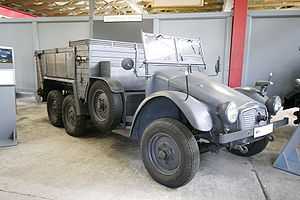Krupp Protze
| Krupp L 2 H 43 / L 2 H 143 / Kfz.70 | |
|---|---|
 Krupp Kfz.70 on display at Deutsches Panzermuseum, Germany. | |
| Type | Artillery tractor / Utility truck |
| Place of origin |
|
| Service history | |
| Used by |
|
| Wars | World War II |
| Production history | |
| Designer | Krupp |
| Manufacturer | Krupp |
| Produced | 1934–1941 |
| Number built | 7,000 |
| Variants | Several, see text |
| Specifications | |
| Weight | 2,600 kg |
| Length | 5.10 m |
| Width | 1.93 m |
| Height | 1.96 m |
| Crew | 1 + 7 passengers + 1 light towed gun |
|
| |
| Armor | None |
| Engine |
Krupp Boxer motor, 3.3 liters 53 or 60 hp |
| Payload capacity | 1,150 kg |
| Fuel capacity | 110 liters |
Operational range | 450 km (on road) |
| Speed | 70 km/h |
The L 2 H 43 and L 2 H 143 "Krupp-Protze" (unofficial designation) was a six-wheeled German truck and artillery tractor used by German forces in World War II. It was powered by a 55 hp or 60 hp (since 1936) Krupp M 304 4-cylinder petrol engine. Its main purpose was to tow artillery, especially the PaK 36, and transport motorized infantry.
This vehicle was extensively used on the Eastern Front, during the North African campaign and in France and Sicily. The "Krupp-Protze" was of relatively advanced design. It was mass-manufactured between 1933 and 1941. Its fuel consumption was relatively high (24 Litres / 100 km on road) in comparison to the comparable Opel Blitz 1.5 t truck (16.5 liters / 100 km, produced 1938 - 1942). Total production was about 7,000 units.
Variants
A successful design, the Krupp-Protze was converted into several variant configurations:
- Kfz.19 - Telephone truck
- Kfz.21 - Staff car
- Kfz.68 - Radio mast carrier
- Kfz.69 - Standard configuration for towing the 3,7 cm PaK 36
- Kfz.70 - Standard configuration for personnel carrying
- Kfz.81 - Ammo carrier conversion for 2 cm FlaK gun, usually towed
- Kfz.83 - Generator carrier for anti-aircraft spotlight, usually towed
- Sd.Kfz. 247 Ausf. A - Armoured personnel carrier, six-wheeled version, only 20 built in 1937; production went to Daimler-Benz, who built the Ausf. B four-wheeled version in 1941 and 1942.
Sometimes anti-tank (36 mm Pak 36) and anti-air (2 cm Flak) guns were mounted directly on the truck bed.
See also
- List of World War II military vehicles of Germany - by name
- List of German military vehicles of World War II - Trucks - by type
References
Notes
Bibliography
External links
- Pictures at Olive-Drab.com
- Pictures and technical data
- Pictures of a Krupp-Protze carrying a PaK 36
- Info and pictures about Krupp Protze